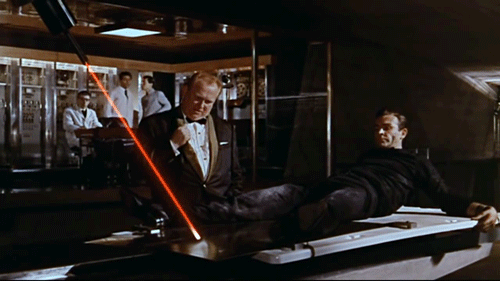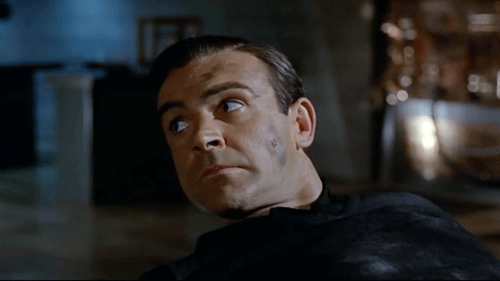"No, Mr. Bond. I Expect You To Die!" The Red-Hot Story Behind ‘Goldfinger’s Laser Scene

Gert Fröbe and Sean Connery in ‘Goldfinger’
By Adam K. Raymond
Forget all those high-tech gizmos and fancy-pants fashion accessories. James Bond may be an international man of mystery, but one thing about 007 is obvious: He lives for sex.
Threatening Bond’s manhood therefore threatens his existence, something few characters have known better than the titular villain in Goldfinger. On the eve of the new Bond movie SPECTRE’s release, we’ve listened to the 1964 film’s DVD commentary tracks and dug through a handful of books to go behind-the-scenes of one of the most iconic Bond sequences ever shot: the tense, four minute stand-off that brings a laser within inches of 007’s crotch.
Related: 13 Things You Didn’t Know About ‘Goldfinger’
But first, let’s go back to the original novel, which was written in 1959, before the first laser was even built. Author Ian Fleming’s version of the scene has Bond staring down the blade of a circular saw as it whirrs menacingly toward him.
Goldfinger co-screenwriter Richard Maibaum knew he had to change that. If the circular saw remained “we were sure audiences would find the episode old-fashioned, hackneyed and ridiculous,” Maibaum says in the 1999 book License to Thrill: A Cultural History of the James Bond Films. “We substituted an industrial laser beam, a development as fresh as tomorrow, for the antiquated circular saw.” It would be Maibaum’s second greatest contribution to the scene, surpassed only this exchange:
Bond: “Do you expect me to talk?”
Goldfinger: “No, Mr. Bond. I expect you to die!”
Watch part of the scene:
But the villain —an international gold smuggler who Bond’s been tailing — doesn’t get what he wants. Despite having Bond (Sean Connery, at the peak of his 007 powers) under his thumb and just seconds from death, Goldfinger (Gert Fröbe) releases 007 after he’s convinced that the spy knows the details of his evil “Operation Grand Slam.” It’s not true. Bond knows nothing more than the plot’s name, which he picked up while spying on Goldfinger. It’s a game of chicken that Bond wins with a bluff, saving his life and allowing him to eventually take down Goldfinger before he accomplishes his master plan: destroying Fort Knox.
The scene may be simple, but the technology in it was anything but. The laser was so new at the time of the film’s release that even scientists were struggling to come up with practical applications. And most people who would be paying to see Goldfinger would have likely not even heard of it. That’s why Maibaum included some crystal-clear exposition near the beginning of the scene.
“You are looking at an industrial laser, which admits an extraordinary light not to be found in nature. It can project a spot on the moon, or at closer range, cut through solid metal. I will show you,” says Goldfinger, the big-bellied, gold-hoarding baddie expertly played by German character actor Fröbe. (His voice, it should be noted, was provided by the actor Michael Collins, who dubbed dialogue for the non-English speaking Fröbe.)
Related: Who Is the Best Bond? We Make the Case For Each One
With Maibaum having solved the problem of explaining the technology, director Guy Hamilton set out to tackle the challenge of capturing it on film. First, he tried the real thing. “They brought a real laser which looked great, a pencil thin line,” optical effects supervisor Cliff Culley says on the DVD’s commentary track. “But as soon as you turned all the studio lights on, it disappeared.” Hamilton resorted to plan B: inserting the glowing ruby light of the laser during post-production.
But the table itself still had to be cut to give the impression that the laser was slicing through the metal. “We had to pre-cut the area which was going to melt and very carefully fill the hole in with solder to make the top look like gold,” special effects technician Bert Luxford says on the commentary track.

The laser beam getting closer
During filming, Luxford was under the table with a welder’s torch burning a line through the table. “I followed my cues exactly and was listening to Gert and Sean’s dialogue carefully, too, as I knew it would end, and laser switch off, after Sean mentioned 'Operation Grand Slam.’ I was about three inches from his crotch when I stopped,” Luxford recalls in his book Albert J. Luxford, the Gimmick Man. “As I got nearer and nearer to his crotch, Sean was sweating a bit. I hate the thought of ever injuring an actor, but 'there’ would have been awful!”
Connery actually spent a dreadful three days strapped to a table in Pinewood Studios London lot shooting the scene. Hamilton “took pleasure in making things difficult for me,” Connery says in a Blu-ray featurette. And this scene was among the film’s most trying for Connery given what was happening beneath him. “He wasn’t very comfortable,” Culley says on the commentary track. In an interview with the LA Times earlier this year, production designer Ken Adam said that that was an understatement. “Sean was absolutely terrified.”

Sean Connery looking genuinely alarmed
Press materials put out before Goldfinger’s release played up the scene and its use of cutting edge technology. The film “is sure to give the laser its greatest international publicity as a scientific development of great power and worth in the modern world,” the release said.
It’s a lofty prediction that’s impossible to evaluate 51 years later. Yes, the laser has become an integral part of modern science — but did Goldfinger have anything to do with that? The scene’s influence on modern pop culture is much easier to measure, though. Just consider all the parodies and homages that have cropped up in the decades since Goldfinger strapped Bond to a table in that unnecessarily large torture chamber. Mike Myers did it, Archer did it. And, as ever, The Simpsons did it best of all:
